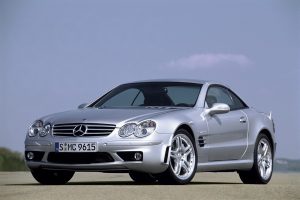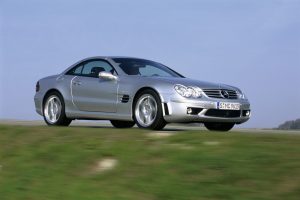Recalls: Mercedes R230 SL AMG
Overview
Manufacturers, or importers, issue recalls for defects or faults which have the potential to cause injury. Generally, manufacturers will inform the original buyers if their vehicle is subject to a recall and of the steps required to remedy the defect or fault. Please note that the recalls below (if any) are for Australian-delivered vehicles only. Furthermore, the number of recalls should not be taken as an indication of a model’s reliability or its safety more generally.
Recalls: Mercedes R230 SL AMG
- In June 2005, a recall was issued for Mercedes R230 SL vehicles due to potential faults with certain functions of the Sensotronic Brake Control (SBC) system (PRA 2005/7815).
- In September 2008, a recall was issued for Mercedes R230 SL models with the Active Body Control (ABC) suspension due to a fault with the front axle body acceleration sensors. Due to an incomplete soldering process during manufacture, certain electrical connection on the circuit boards of the ABC sensors could trigger random sprung mass vibrations at the front axle of the vehicle. This could influence driving stability, operational safety and, in some cases, display a warning message in the instrument cluster (PRA 2008/10321).
Problems and faults: Mercedes R230 SL 55, SL 63 and SL 65 AMG
Overview
This section identifies potential problems, causes and fixes based on the experiences of owners and repairers, online sources and technical service bulletins. This information is provided solely for reference purposes and AustralianCar.Reviews recommends that only properly qualified persons carry out repairs or modifications. Furthermore, the number of items below should not be taken as an indicator of a model’s reliability or the frequency with which they may occur.
To report a problem or fault to the AustralianCar.Reviews team, please use the Contact Us form. Note that AustralianCar.Reviews does not offer advice on automotive problems or disputes; such enquiries will not receive a reply. For vehicles purchased from dealers after 1 January 2011, please see our Australian Consumer Law fact sheet.
M156 engine (SL 63 AMG): cylinder head bolt failure
For 6.2-litre M156 engines with engines numbers up to 1569xx 60 060658 (corresponding to engines produced from 2006 to the first half of 2010), the cylinder head bolts can stretch and snap.
The M156 engine has ‘torque to yield’ bolts which are designed to achieve a specific clamping pressure by being tightened to a specific torque and then turned a specific number of degrees. To achieve the intended clamping pressure, the upper section of the bolts is designed to stretch slightly. While the exact cause is unclear, it has been suggested that the design of the bolts, their metallurgy or corrosion causes them to stretch and snap.
The failure of one head bolt puts additional stress on the other bolts, causing further failures. The loss of clamping pressure allows coolant and oil to enter the combustion chamber; coolant can also be forced up through the failed head bolt locations into the top of the heads, causing white smoke and a rough idle. In severe cases, the cylinders can experience hydro lock, causing the piston to seize and destroying the entire engine.
Symptoms of head bolt failure are:
- Repeated low coolant levels;
- High oil level (from coolant getting into the oil);
- Illumination of the check engine light (CEL); and,
- White exhaust smoke (burning oil).
To test for head bolt failure, the coolant system could be pressurised and allowed to sit over night to see if the coolant level had dropped and if coolant was present in the oil.
In April 2011, Mercedes-Benz issued service bulletin LI01.30-P-051567 regarding broken cylinder head bolts for the M156 engine which caused coolant to enter the engine oil and/or the combustion chamber. The service bulletin identified the following symptoms:
- CEL (Check Engine Light) illumination;
- Misfire;
- Rough running; and,
- Low coolant indicator illumination.
To fix, the cylinder heads had to be removed so that the piston deck height could be measured. If the measurement from the top surface of the crankcase to the top surface of the piston was outside of specification (the maximum deck height was 0.23 mm), then the affected connecting rod with piston and bearings had to be replaced. As part of the repair, all cylinder head bolts and hydraulic tappets were to be replaced.
M156 V8 engine (SL 63 AMG): camshaft lobe and valve lifter wear
In a US class action – CEDRIC CHAN v. DAIMLER AG, MERCEDES-BENZ, MERCEDES-BENZ USA, LLC and MERCEDES-AMG GMBH – it was alleged that the combination of nodular cast iron camshafts and valve lifters made of 9310-grade steel resulted in premature wear of the M156 engine as a result of:
- the soft camshaft metal, and/or
- improper heat treating, and/or
- improper camshaft offset.
Specifically, the camshafts were designed so that the lobes would contact the valve lifters. When the camshaft lobes experienced wear, the surface would become rough or scored and no longer make contact with the lifters with the same precision – this would cause the lifters to wear prematurely, demonstrated by a gouged ring in the top of the valve lifter. The gouged ring wear on the buckets also indicated that the buckets were not spinning as intended. The result of this premature wear would be serious engine failure.
Symptoms of camshaft lobe and valve lifter wear include rattling or clattering noises on start-up. In service bulletin S-B 05.20/20b (produced in 2009), Mercedes-Benz acknowledged the problem of camshaft and valve tappet wear. Ultimately, the class action did not proceed due to the plaintiffs’ lack of standing.
Problems and faults: Mercedes R230 SL AMG
- Under hard acceleration, tapping or knocking noises – like piston slap – may be heard from the engine bay, though it may be that the engine mounts require replacement.
- Banging or thumping noises from the front suspension may be caused by failure of the spring control arm rubber bushing.
- The alternator may not adequately recharge the battery due to a faulty internal voltage regulator.
- The air conditioning (blower) motor may stop working or only work intermittently due to an internal circuit breaker in the air conditioning (blower) motor regulator that requires replacement.
- For early models, the rotors may warp after repeated hard braking; heavier and more heat-resistant rotors were subsequently released.
- The automatic leveling system may allow the vehicle to lower after extended sitting (approx. a week) due to leaking check valve blocks. However, sagging can also be caused by dirty hydraulic fluid, requiring the fluid and filter to be replaced.
- Transmission fluid may leak from the electrical connector on the automatic transmission.
- The battery may be drained by the pneumatic systems continuously running – this may be caused by the ‘keyless go’ or remote boot opening switches sticking.
- The air conditioning compressor may continuously cycle on and off due to a problem in the sensor for the emission control charcoal canister (which sends an incorrect signal to the multiplex bus)
- .Noises from the front suspension may be due to problems with the upper control arms due to torn rubber covers enabling damage to the ball joints.




